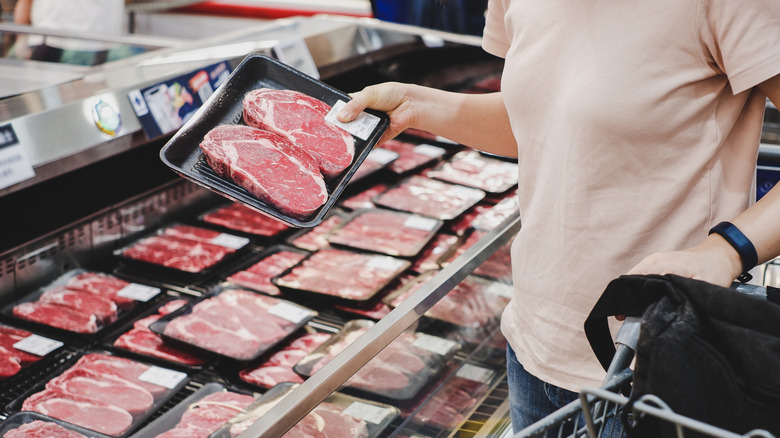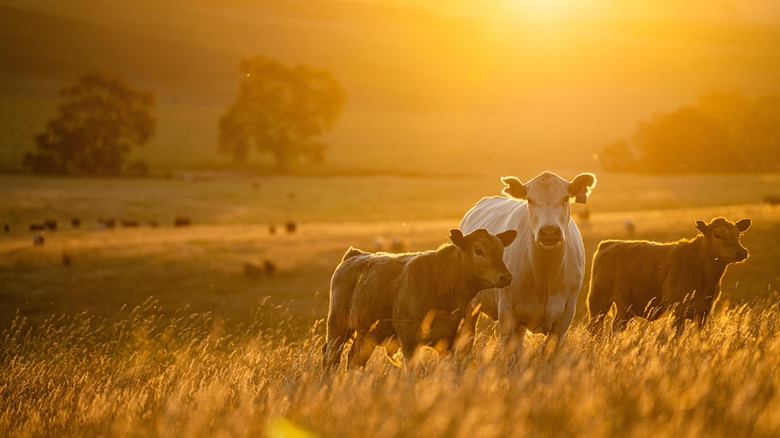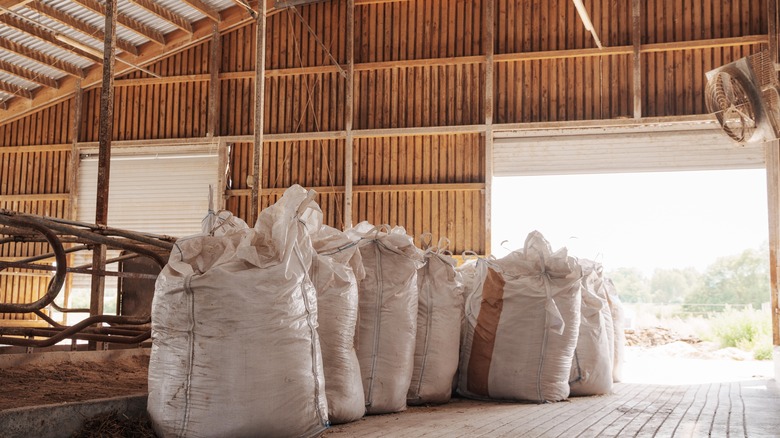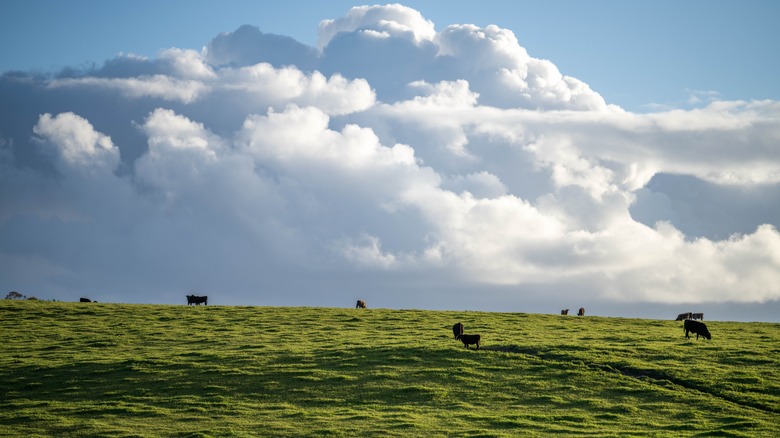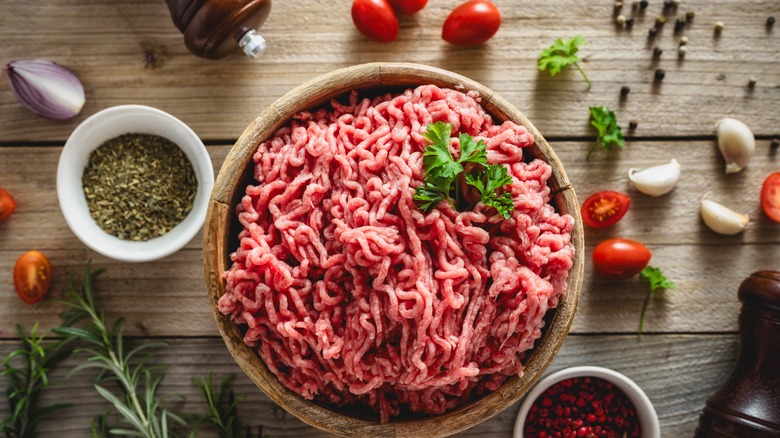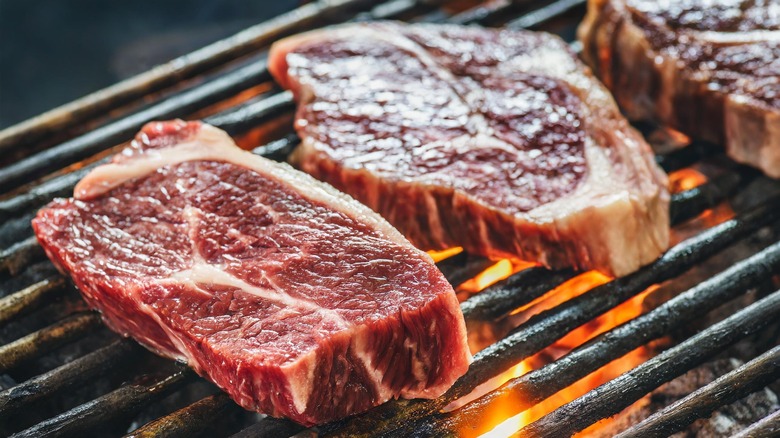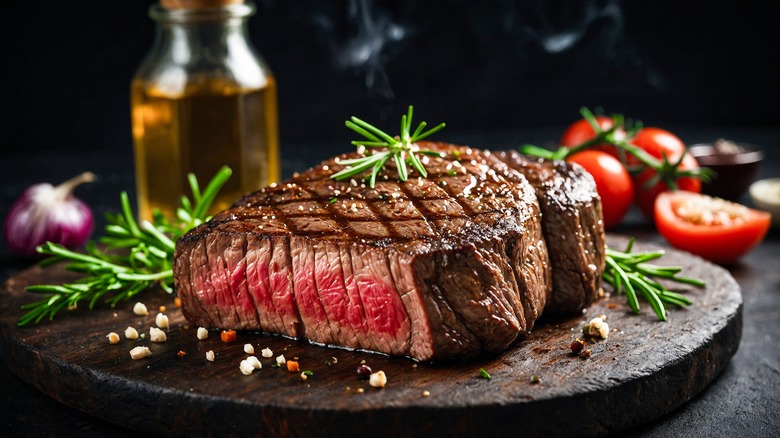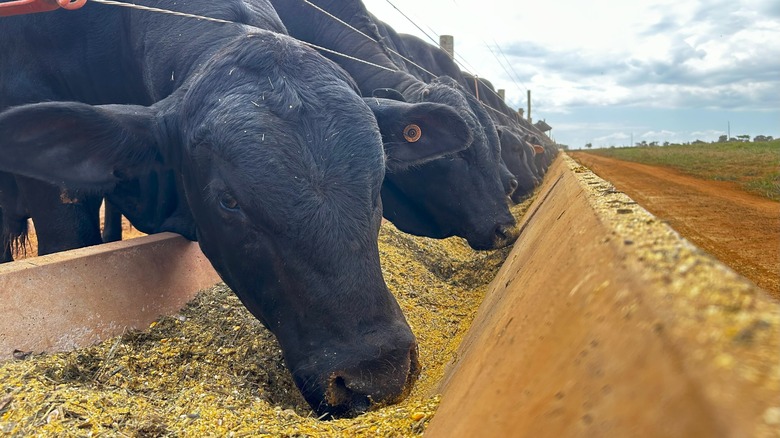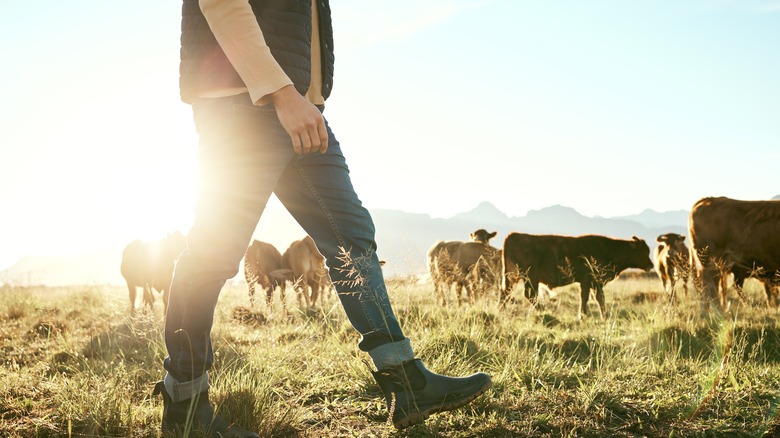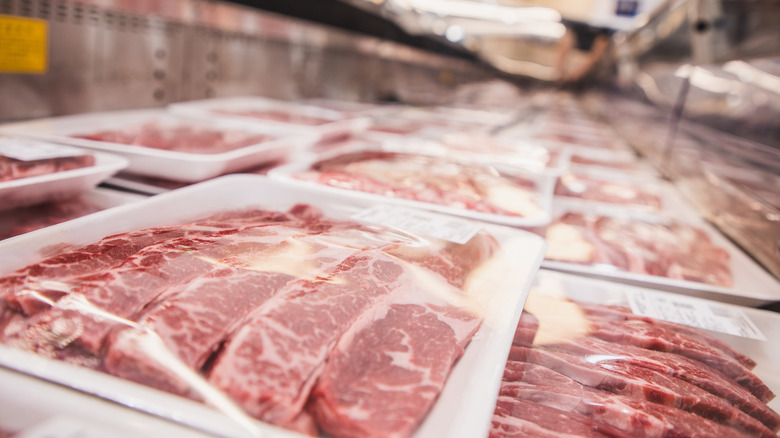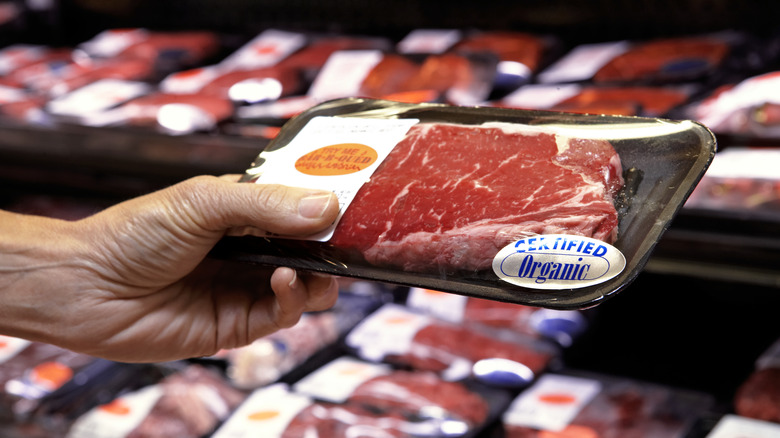Grass-Fed Vs Grain-Fed Beef: How Do They Compare?
Red meat can become a big topic of debate, especially when it comes to health and nutrition. As many people cut back red meat from their diets for health, religious, or environmental reasons, others can't resist chowing down on a juicy steak for dinner or burger at their barbecue. Meanwhile, more options in our grocery aisles are in line with a demand an increasingly awareness about where food comes from. To that end, you may have spotted grass-fed labels in the pack, among many other common phrases on your beef packaging.
Though it can be confusing to determine what these labels actually mean, you don't have to worry. We have broken down what exactly grass-fed and grain-fed beef mean, how they are similar and differ (besides the price point), and what you should know when making your selection. To get the full picture, we spoke to experts ranging from cattle ranchers to chefs, to dietitians, who all weighed in to help you make the best decision about what kind of beef is the best fit for your kitchen.
Grass-fed or grass-finished?
Nailing down terminology is key when discussing beef options. You may see grass-fed/grass-finished and grain-fed/grain-finished used interchangeably. The catch is that all cattle are typically grass-fed for a majority of their lives, at least up until a point. In fact, Omaha Steaks CEO Nate Rempe says, "It's not well understood that all conventional beef (about 99 percent of the beef consumed in the U.S.) is from cattle that spend most of their time grazing on grass in pastures."
What makes grain-fed beef different from grass-fed beef is the four to six-month period cattle spend at a feed yard eating a diet of grains, feed from potato hulls or sugar beets, and hay or forage. That finishing process is why you may see the phrase "grass-finished" on packaging instead of more commonly used "grass-fed" term. "Both grass-fed/grass-finished and grass-fed/grain-finished cattle start on a diet of grass and forage. The primary difference is in the finishing phase, where grass-finished cattle continue to consume grass or forage, while grain-finished cattle are given a diet rich including additional grains to increase fat content and marbling in the meat," said Erin Michalski, cattle rancher at Eagle Rock Ranch.
While experts note that the technically correct term is "finished," we will use the terminology of grass-fed and grain-fed for clarity's sake.
What is grain-fed beef?
Grain-fed is a term you may not see on your meat packaging, as most beef is raised this way and so doesn't necessarily have a specific label claim. Grain-fed beef will also potentially be given FDA-approved antibiotics that treat, prevent or control disease. Cattle may also receive doses of growth-promoting hormones.
"In the U.S. system, all calves are raised on grass and their mother's milk until they reach 'feeder' size, which is roughly between 500 and 700 pounds. At that point, grain-fed animals are sent to a feedlot where they are semi-confined and fed corn and grains intended to put weight on rapidly," said Alec Bradford, Founder of Herd Provisions and Leaping Waters Farm. "Grain-fed beef can reach the proper weight in half the time as grass-fed beef."
You may also notice more consistency in fat that's marbled throughout cuts of grain-fed beef, as there is tighter control over the cattle's diet, according to Jason Kennedy, in-house meat expert with Verde Farms. The grain-fed cattle diet is considered nutrient-rich, Nate Rempe said, which gets it to market faster and keeps costs lower for consumers.
What makes beef grass-fed?
Grass-fed cattle spend their entire lives on a diet of grass or forage, meaning they skip out on the grain-fed step. "Grass-fed animals are left to graze on forage until they reach slaughter size," Alec Bradford said, adding that it typically takes about 30 months to reach slaughter condition.
Grass-fed cattle may also spend time at a feed yard instead of eating grass, forage, hay, or silage. However, you may also see labeling that indicates grass-fed cattle have never visited such feedlots, according to Jason Kennedy. "It's also more likely to be labeled with attributes like no antibiotics, no added hormones, non-GMO, and never confined to feedlots," he said.
Ranchers who raise grass-fed cattle may also have more sustainable or ethical farming practices, while grain-fed beef is produced on a larger scale with more efficient feeding processes, said Trista Best, registered dietitian for Balance One Supplements. Grass-fed cattle also align more with what's many consider to be the animal's natural meals. "Keeping the animal on grass is more consistent with their natural diet and results in a much different product that is definitely leaner. The connective tissue is stronger and the fat is noticeably a different color," said Shane Graybeal, Executive Chef at Fielding's - The Armory Hotel in Bozeman, Montana.
Nutritional benefits of grass-fed beef
Beef typically has a high amount of saturated fat, which is linked to unhealthy blood cholesterol levels. But before you write beef off entirely, both grass-fed and grain-fed varieties have some key nutritional benefits. These include delivering high-quality protein, essential amino acids, and nutrients such as iron and B vitamins, according to Trista Best. "Grass-fed beef is lower in fat than grain-fed beef and the fat content is healthier," she said. "This is because grass-fed beef has a higher amount of omega-3 fatty acids and conjugated linoleic acid (CLA) over grain-fed. This higher omega-3 content is due to the fact that plant sources of this fat is found only in seeds, nuts, and the grass used for cattle grazing." Higher levels of CLA can provide potential benefits like reducing body fat and improving immune function, according to Erin Michalski.
Grass-fed beef may have a lower an impact on cholesterol, too. "The high carotene content of grass-fed beef does not raise cholesterol levels like grain-fed beef does," said Alec Bradford, though research here is ongoing and it's likely better to reach for a lean cut of either type of beef if you want to manage your cholesterol.
There is also a difference in the fat itself found in grass-fed beef. "The fat also is much more nutrient dense in the fat-soluble vitamins- A , D, and K," said Shane Graybeal. Grass-fed beef also packs some extra antioxidants thanks to the cattle's plant-based diet, according to Best.
Nutritional benefits of grain-fed beef
Experts say a big nutritional disparity is that grain-fed beef does not have high levels of omega-3 fatty acids. However, plant sources in grass-fed cattle's diet may boost omega-3 level in that particular type of beef, according to Trista Best. "While [grain-fed beef] may contain fewer omega-3 fatty acids and CLA, it still provides a good source of protein, iron, and B vitamins," said Best. "Both types of beef are nutritious, but grass-fed beef is often chosen for its perceived health benefits and higher omega-3 content." Erin Michalski notes that both grain-fed and grass-fed offer additional nutrients like zinc, vitamins B12 and B6, niacin, and riboflavin.
A 2022 study published in Foods indicates that grain-finished beef contains significantly higher amounts of both omega-6 polyunsaturated and monounsaturated fatty acids compared to grass-finished beef. And while there are higher levels of certain nutrients in grass-fed beef, how it affects your overall health can be a bit more complex. "Many organizations make blanket claims that grass-finished beef is a 'healthier option' over grain-finished. The impact on human health, if any, of choosing grass over grain-finished has yet to be understood," Nate Rempe said, citing the Foods article on whether or not grass-finished beef actually has a direct impact on human health. The study also discusses the importance of considering an individual's whole diet, as well as key factors like exercise, socio-economic status, and healthcare access.
Taste of grass-fed beef
Experts say that cattle's differences in diets have a noticeable impact on the taste of beef. "Grass-fed beef can be remarkably gamey tasting," said Shane Graybeal. "If you're used to eating venison or elk, you might find the flavor to be very close. A good grass-fed animal will have hints of iron flavors and some sweetness."
Alec Bradford said the taste can be further affected by how the cattle are raised. "Grass-fed will have more flavor, some people might even find it gamey. This is generally true in animals that are raised in a well-organized rotational grazing system that has diversified grasses growing on a schedule to meet the dietary needs of the cows," he said. "Simply putting animals in a field and hoping for the best yields an inferior product."
The taste can also correlate with geographic location. "The majority of grass-fed beef is coming out of Australia and South America, so by the time it's on shelves it could be up to 100 days old," said Jason Kennedy. "The significance of this is it creates an improved eating experience as the process of 'wet aging' has allowed natural enzymes to help tenderize the meat, but in a safe controlled manner [...] I've eaten the best Australian meat in the USA solely due to this factor."
Taste of grain-fed beef
Grain-fed beef is often described as more mild and much more tender than its grass-fed counterpart. "Grain-fed beef tends to have a milder, richer flavor and more tenderness, attributed to the higher fat content from grain-based diets," said Trista Best. "The increased marbling in grain-fed beef often results in a juicier and more buttery mouthfeel, which many people find desirable."
The higher total fat found in grain-fed beef contributes to that texture, making it, "often preferred in culinary contexts and around dining room tables," Erin Michalski maintained. "This type resembles your typical 'steakhouse' flavored steak."
Nate Rempe believes taste is a personal preference, but "That said, most people — even beef experts — overwhelmingly prefer grain-finished beef. It provides that rich, buttery and authentic beef flavor," he noted. "For most people looking to buy a great steak or juicy burger, expectations align well with grain-finished beef to get that unmatched flavor and tenderness."
Cooking with grass-fed or grain-fed beef
You may also be wondering if the cooking technique needs to change between grass-fed and grain-fed beef. The good news is that our experts informed us that grass-fed and grain-fed beef can generally be used interchangeably in recipes. "Grass-fed and grain-fed are similar in the sense that regardless of what cut you choose, either option will be suited to the same cooking methods (Grilling, stir fry, cast iron, etc.). You don't need to avoid certain cooking methods when choosing grass-fed or grain-fed beef," said Jason Kennedy.
However, you may want to be mindful of the tenderness and fat content of your particular cut of meat. For example, the somewhat lower amount of fat in grass-fed beef means you need to take extra steps before grilling a steak. Expert pit master Rodney Scott told Mashed that tenderizing meat with a mallet can help to replicate the tenderness of fattier grain-fed beef. On the other hand, a grass-fed steak typically boasts more flavor and can achieve a better sear.
Animal welfare considerations
Animal welfare can also be a major factor for consumers who are choosing between grass- or grain-fed beef. "Grass-fed cattle are typically raised in more natural conditions," said Samuel Davis, a horticulturist and the CEO of London Gardeners. "[This] can result in better animal welfare compared to grain-fed cattle raised in confined feedlots."
Erin Michalski said that you can't assume that one type of cattle is raised better than another. "Both grass-fed and grain-fed cattle can come from farms and ranches that practice humane animal treatment, although this can vary widely by producer," she said, adding that both types of cattle could live in feedlots, pens, or in a pasture.
"For example, a grass-fed/grass-finished steer could live in a small pen and be fed forage, but never graze on pasture land," Michalski continued. "On the contrary, a grass-fed/grain-finished steer could have 24/7 free-range pasture access and simply have an additional 5 pounds of grain poured into a bucket for him to eat in addition to his pasture grass. Likewise, the contrary can be true. Hence it's very important to make the distinction of how an animal is raised, and not just what it is fed." Ultimately, if you're especially concerned about animal welfare, it's better to investigate a particular supplier's practices than simply glance at the label.
Environmental impact of grass- and grain-fed beef
"Grass-fed beef often has a lower environmental footprint" compared to grain-fed, said Samuel Davis. "Grasslands sequester carbon, reduce soil erosion, and support biodiversity, aligning with sustainable land management principles." Alec Bradford echoed this sentiment, saying that "Grass-fed beef is exponentially less damaging to the environment. Everything from methane emission to feedlot runoff to fertilizer leeching combine to make grass-fed much better for the environment."
You'll likely also want to consider how animals work within a given environment. "Counter to the narrative of beef being harmful to the environment, well-treated animals are an integral part of our ecosystem. Closed loop farming and regenerative farming is the only future we can be taking seriously," said Shane Graybeal. "A well-cared-for animal gives back more minerals and nutrients than it takes in. Industrial food creates a lot of issues that are being ignored so if you are given the choice, go grass-fed."
Some experts note that grass-fed cattle require more land and time to raise, which can impact environmental considerations. But it's complicated. "Grain-fed/grain-finished cattle [are] often blamed for a higher environmental footprint due to the resources needed to grow grains and the emissions from concentrated animal feeding operations," Erin Michalski said. "Yet these animals take less time to prepare for slaughter so ultimately may have a lower environmental impact than a 'grass-finished' cow."
How do costs compare?
Shoppers will typically find grass-fed beef to be more expensive than grain-fed. Prices can go up depending on a variety of factors, including the particular cut of meat and whether or not it is organic. "Because the animals live quite a bit longer and require more attention over that time, grass-fed beef costs more to produce than grain-fed," Alec Bradford said. "There are wide discrepancies in price between grass and grain, grain and grain and grass and grass, this can be due to any number of factors, price alone is no indicator of quality."
If cost is the sole deciding factor, grain-fed beef is typically cheaper. "Grain-fed beef, produced on a larger scale and with more efficient feeding processes, tends to be less expensive and more widely available, making it a more economical option for consumers," said Trista Best. If your heart is set on grass-fed beef but you're still budget-conscious, Shane Graybeal suggested sourcing your meat from local farmers and ranchers, as "the cost is rarely an issue on that level."
There are also other factors that contribute to beef prices, regardless of whether it's grass-fed or grain-fed. "Price differences will vary depending on many factors including the cut of beef, overall beef supply, and consumer and commercial demand," Nate Rempe explained. "Currently, beef prices are elevated in the U.S. as a constricted supply is met with continued, strong consumer demand."
Other considerations when buying beef
Grass-fed and grain-fed are only two of the choices you may have at a grocery store when browsing the beef selection, which can also include phrases like "organic" and "natural." Both certified organic and naturally-raised cattle typically have never consumed any antibiotics or growth-promoting hormones and may be either grain- or grass-fed. However, to be certified organic, the USDA must certify the feed is 100% organically grown. Meanwhile, "natural" isn't technically subject to such rules, though the FDA notes it has a "longstanding policy" that defines natural food as being free of unexpected artificial or synthetic ingredients.
Shoppers also want to pay attention to the fat marbling on cuts of meat. "A key when selecting grass-fed ribeyes or striploins is to look for signs of marbling (the internal specs of fat), something you can often find if you look through what's available on the shelf," said Jason Kennedy. "I grab grass-fed grinds as a preference but also grass-fed steak when it's going to be slow-cooked."
Whatever you end up choosing, Shane Graybeal said that "In the end, cows are mono-gastric and can process and eliminate many toxins they are exposed to (namely in the form of glyphosate-laden grains) so don't split hairs at your local grocery store. But if you care about your health and a better food system, grass-fed all the way."
Sourcing grass-fed or grain-fed beef
All told, it's relatively easy to find both grass- and grain-fed beef at your local grocery — and it could even become easier to find grass-fed meat. "Grass-fed has grown significantly over the last 6-7 years, largely due to the healthy benefits and animal welfare it offers," said Jason Kennedy. "I see the growth will continue with the U.S. herd numbers being at such a low point."
However, if you don't have access to grass-fed beef, you can potentially order it online. '"Finding high-quality beef of either variety often requires a bit more searching," said Alec Bradford. "From specialty butcher shops to the wonders of the internet, it is always possible to put your hands on some great cuts of whichever is your preference."
Trista Best suggests checking specialty health food stores or farmer's markets if you are having trouble finding options at your more conventional grocery store. You may also order meat directly from ranchers. If all else fails, Shane Graybeal says you can ask your local grocer to stock your preference. "Just ask for it! Customer demand is what drives our free market," he said.
